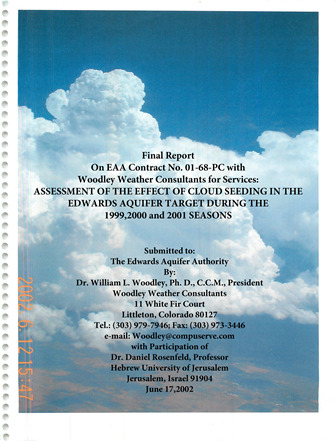Assessment of the Effect of Cloud Seeding in the Edwards Aquifer Target During the 1999, 2000 and 2001 Seasons

| Summary |
|
This is the Final Report from Woodley Weather Consultants (WWC) to the Edwards Aquifer Authority (EAA) under Contract 01-68-PC between WWC and the EAA. The [sic] has entailed a comprehensive evaluation of project operations for the 1999, 2000 and 2001 seasons, including the seeding flights, record-keeping and data management procedures. WWC has also made an assessment of the effect of seeding in and downwind of the EAA target using a new, objective, comprehensive, computer-based method of evaluating operational cloud seeding programs. Finally, daily gauge vs. radar rainfall comparisons were made for the new EAA gauge network for the 2001 season…. The operational review determined that project documentation and data handling were good during the 1999, 2000 and 2001 seasons. …WWC made a major breakthrough under the contract in its efforts to develop an objective and comprehensive method of evaluating the operational cloud seeding programs on an area basis in Texas. The new procedures have been applied to the Edwards Aquifer project for the 1999, 2000 and 2001 seasons and the results are documented in considerable detail herein…. Further analysis provided additional insights into the effects of seeding. Although the response diminished with time, it seemed to persist in many cases for up to 8 hours. If the units are moving, this means that the effect of seeding is not limited to the boundaries of the target but rather extends outside the target downwind. Thus, those living outside a seeding target in a region that is normally downwind of the seeding activity are benefiting from the enhanced rainfall without having to pay for it…. The results of the Edwards project to date warrant its continuation, although there is considerable room for improvement, particularly in initiating seeding at the time and place it will be most effective. The Edwards target seems too large for two seeding aircraft. Either the target size should be reduced or the number of seeding aircraft increased for maximum seeding effectiveness. If picking the former option, the seeding should be focused on the portion of the target where it will do the most good. With respect to the Edwards target this would appear to be in the recharge zone for the Edwards Aquifer in the western and northwestern portions of the target. More seeding should be done over longer time periods. Night seeding should be done, if it can be done safely and efficiently…. Since then, the EAA governing board decided to continue its seeding program for the 2002 season by providing financial support to the South Texas and Southwest Texas operational seeding programs to seed the western portion of the EAA target, constituting the major recharge zone for the Edwards Aquifer. … The benefit to cost ratio after three seasons of cloud seeding of nearly 12 to 1, supports this action. Upon considering this apparent benefit, the obvious recommendation is that the seeding program should continue, and the action for the 2002 season is consistent with this recommendation. The installation and activation in 2001 of the EAA recording rain gauge network was a major milestone for the seeding project and for the EAA overall, permitting documentation of systematic radar underestimation of the aquifer rainfalls by about 56%. Adjustment upward of the Edwards Aquifer radar rainfall estimates by 56% brought them into better agreement with rainfall estimates elsewhere in Texas. In addition, this adjustment facilitated a more realistic estimate of project benefits relative to its costs. This rain gauge network is now a major asset to the EAA and the resources needed to keep it in good working order should be expended. Finally, it is recommended that the data generated by the EAA cloud seeding effort be used to relate radar-estimated, gauge-adjusted, target rainfalls to recharge of the Edwards Aquifer. This can be done in any time frame for areas of any size in the Edwards Aquifer. Knowing how the Aquifer responds to rainfall as a function of its intensity, duration, total amount, and location will make it possible to focus cloud seeding activities on the portions of the Aquifer that will be most beneficial. The development of rainfall vs. recharge relationships based on years of observations also will be valuable to the development of realistic hydrological models for the Edwards Aquifer. |
Search for Documents
Advance Search
Explore EAA's Scientific Reports
- All Reports
- Water Quality
- Climatology
- Surface Water / Groundwater Relationship
- Biology
- Springs, Groundwater Discharge
- Archaeology
- RZ Protection
- Aquifer Levels
- Remote Sensing
- Precipitation
- Overview Studies
- Modeling
- Hydrology and Hydrogeology
- History
- Groundwater Recharge, Recharge Zone
- Groundwater Movement
- Geomorphology and Caves
- Weather Modification
- Geology
- Water Use and Conservation
- Geochemistry
- Water Resources Planning and Management
- Floods and Drought
